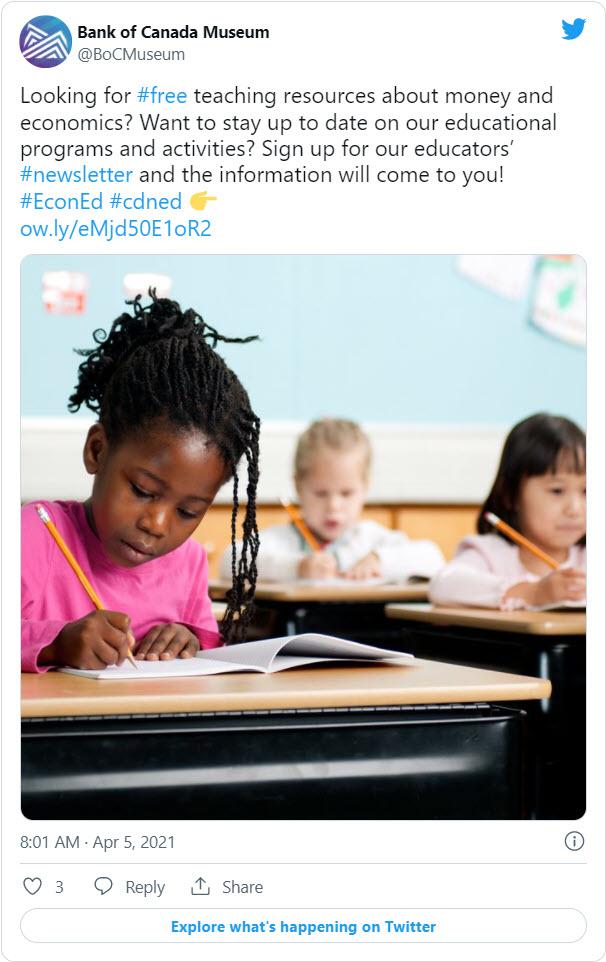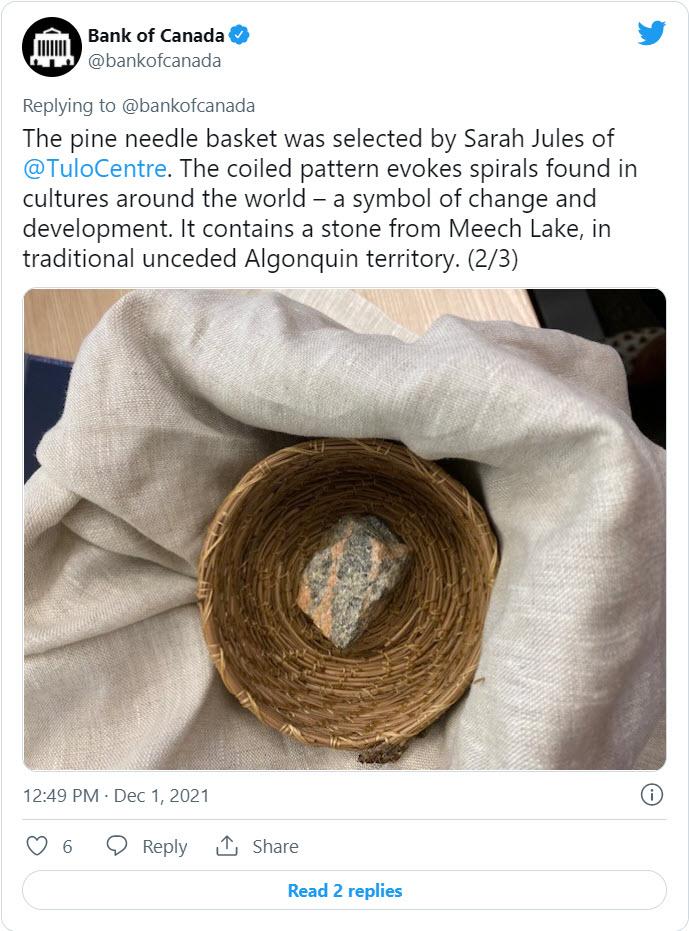
Communications and outreach
As the pandemic entered its second year, the Bank’s communication efforts remained focused on explaining the extraordinary measures put in place to foster economic recovery. The Bank also began laying out its plans for adjusting monetary policy as the economy returns to its full potential.
As it does every five years, the Bank renewed its monetary policy framework agreement with the Government of Canada. The renewal of the framework followed three years of research and engagement with Canadians. It provides continuity and clarity and addresses important changes in the economy. With inflation well above the target, the renewed agreement was an important opportunity to reaffirm price stability as the primary goal of monetary policy, while also articulating the flexibility inherent in the framework.
While the pandemic made stakeholder and public engagement more difficult, the Bank continued to expand and deepen its outreach, particularly on the topics of:
- the economic impacts of COVID‑19
- the renewal of Canada’s monetary policy framework
- retail payments supervision
The Bank also continued its efforts to improve relationships and enhance collaboration with Indigenous Peoples.
In 2021, the Bank introduced its new Senior Deputy Governor, Carolyn Rogers, to Canadians. It also announced the appointment of a new Deputy Governor, Sharon Kozicki, as well as the first Executive Director for Retail Payments Supervision, Ron Morrow.
Being transparent and fostering understanding
For the past several years, the Bank has improved how it communicates so that it can help Canadians understand what it does. This goal guided its communications more than ever in 2021.
The Bank remained committed to communicating in easy-to-understand, relatable language. It used a range of channels, including:
- speeches
- media interviews
- web content
- social media
- educational materials
- stakeholder consultations
Speech summaries
Throughout the year, the Governor and other members of Governing Council spoke regularly about the programs the Bank put in place during the pandemic. They also shared the Bank’s expectations for how the recovery is likely to unfold. Alongside every speech, the Bank published a plain language summary to highlight the speech’s key messages.
Explainers
In 2021, the Bank published new explainers—brief articles that translate complex ideas into everyday language—on several topics, including:
- monetary policy
- the target for the overnight rate
- the consumer price index
The Bank also created a dashboard on its website to show the progress of the labour market recovery.1
Financial System Hub
The Bank used its Financial System Hub to share articles of public interest on financial stability issues. In 2021, new content focused on:
- housing market imbalances and household indebtedness
- the impact of the COVID‑19 pandemic on the financial health of Canadian businesses
- climate-related risks
Data accessibility
As part of its ongoing efforts to promote transparency, the Bank made its data more accessible. Specifically, it improved its Valet API—a tool integrated into the Bank’s website that allows people to easily retrieve data. Users accessed the API more than 11 million times in 2021. The Bank also published transaction-level data for the asset purchase programs it established early in the crisis and later discontinued.
Bringing the Museum to Canadians
The Bank of Canada Museum was closed to visitors for 2021 because of the pandemic. However, it continued to reach thousands of Canadians by:
- offering lesson plans and other educational materials to teachers at the primary and secondary levels
- participating in several teachers’ conferences to consult with educators across the country
- making kids’ activities available through its website and social media
- organizing a virtual speaker series in which experts discussed topics related to the economy
Looking for #free teaching resources about money and economics? Want to stay up to date on our educational programs and activities? Sign up for our educators’ #newsletter and the information will come to you! #EconEd #cdned https://t.co/sDf42eeMLW pic.twitter.com/Ul1PH6gKcL
— Bank of Canada Museum (@BoCMuseum) April 5, 2021

https://twitter.com/BoCMuseum/status/1379041441779957766
Involving Canadians in the Bank’s work
To better serve Canadians, the Bank actively engages with them—particularly when its policies and initiatives have the greatest potential to affect them.
Understanding Canadians to serve them better
In 2021, the Bank conducted public opinion surveys and focus groups to understand how Canadians perceived its work during the pandemic. It used the results to adapt its communications to the public’s needs and preferences.
Public trust in the Bank remained solid. Compared with pre-pandemic numbers, more Canadians believed that the Bank’s decisions are relevant to them.2
Publishing the results of our consultations on inflation and the monetary policy framework
After concluding broad public consultations in the lead-up to the renewal of the monetary policy framework, the Bank published a detailed report summarizing what it heard from Canadians—including their perceptions on inflation.
Expanding consultations and engagement activities with key stakeholders
To further its understanding of how its policies affect specific groups of Canadians, the Bank continued to expand its targeted engagement activities. For example, it held round-table meetings with:
- labour groups
- civil society organizations
- business and trade associations
These were used to discuss the impact of COVID‑19 and how the economy will look in the aftermath of the pandemic.
In 2021, the Bank co-founded the Central Bank Network for Indigenous Inclusion with its Indigenous partner organization, the Tulo Centre of Indigenous Economics,3 and consulted with other Indigenous organizations, such as the First Nations Finance Authority, to understand how monetary policy affects their members. In November, the Bank collaborated with the Tulo Centre and the Reserve Bank of New Zealand to host the first Symposium on Indigenous Economies. The symposium featured 51 speakers and was attended by 425 participants.
The Bank also significantly expanded its outreach related to a central bank digital currency and retail payments supervision.
The pine needle basket was selected by Sarah Jules of @TuloCentre. The coiled pattern evokes spirals found in cultures around the world – a symbol of change and development. It contains a stone from Meech Lake, in traditional unceded Algonquin territory. (2/3) pic.twitter.com/8edSjTknyw
— Bank of Canada (@bankofcanada) December 1, 2021

https://twitter.com/bankofcanada/status/1466102178431610887
Promoting and supporting research
The Bank engaged with academics, research partners and students through a variety of initiatives, conferences and programs.
The Bank also highlighted current research through a monthly newsletter and website.
Looking forward
To ensure it remains a relatable and trusted Canadian institution, the Bank will:
- continue to increase its accountability and relevance through clear, accessible communications
- engage directly with a broader set of stakeholders to better understand their diverse points of view
- raise public awareness of the Bank’s emerging areas of responsibility
- expand the scope and reach of its educational programming about the economy
- continue to offer virtual programs for schools and reopen the Bank of Canada Museum, offering in-person programs when public health restrictions have been lifted
- work with a broad spectrum of Indigenous groups to develop a reconciliation action plan for the Bank
- work to ensure the Bank’s content and events meet or exceed the requirements set out in the Accessible Canada Act
- 1. Bank of Canada, “Labour Market Recovery from COVID‑19.”[←]
- 2. Learn more about the results of the Bank’s Public Awareness Surveys.[←]
- 3. Bank of Canada, “Bank of Canada Becomes Inaugural Member of New, International Central Bank Network for Indigenous Inclusion” (press release, April 27, 2021).[←]